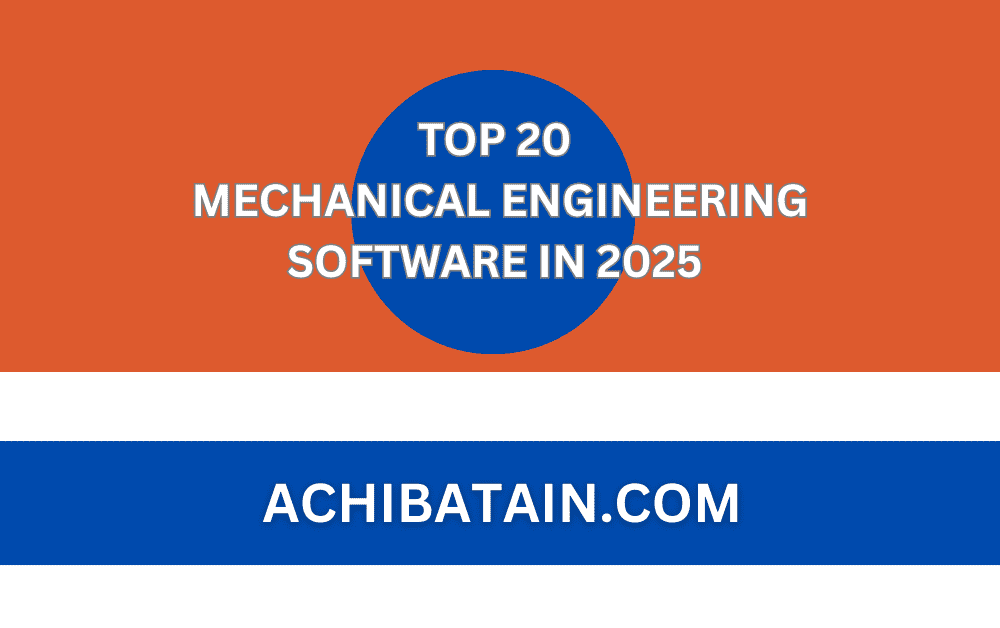Top 20 Mechanical Engineering Software in 2025: Essential Tools for Innovation
The top 20 mechanical engineering software in 2025, from CAD giants like SolidWorks and CATIA to simulation powerhouses like ANSYS. Optimize your workflows with cutting-edge solutions.
Introduction
The mechanical engineering landscape in 2025 is defined by rapid technological advancements, from AI-driven design to cloud-based collaboration. Choosing the right software can make or break a project’s success. This article highlights the top 20 tools revolutionizing mechanical engineering, backed by industry trends and expert insights.
The Ultimate Guide to Mechanical Engineering Software in 2025

1. SolidWorks
A staple for 3D modeling, SolidWorks excels in precision design, assembly modeling, and simulation. Its intuitive interface makes it ideal for automotive and industrial equipment design. Key features include stress analysis, sheet metal tools, and motion studies.
Best For: Complex assemblies, prototyping, and dynamic simulations.
2. CATIA (Dassault Systèmes)
CATIA dominates aerospace and automotive industries with its ability to handle intricate surface modeling and large-scale projects. Its parametric design tools and digital twin integration streamline innovation for companies like Boeing and Tesla.
Best For: Aerospace structures, automotive surfaces, and advanced prototyping.
3. Siemens NX
Siemens NX combines CAD, CAM, and CAE into a unified platform. Known for its generative design and cloud collaboration, it’s a favorite for enterprises needing end-to-end product lifecycle management 411.
Best For: Digital twins, additive manufacturing, and multi-disciplinary engineering.
4. Autodesk Inventor
Inventor 2025 introduces AI-driven automation for sheet metal design and drawing documentation. Its parametric modeling and BIM integration make it a versatile choice for machinery and consumer product design.
Best For: Mechanical systems, automated documentation, and realistic renderings.
5. AutoCAD Mechanical
A specialized variant of AutoCAD, this tool streamlines 2D drafting and 3D modeling with a library of 700,000+ standardized parts. Ideal for technical drawings and piping systems.
Best For: Technical documentation, legacy design updates, and manufacturing blueprints.
Read this post also:
Best Betavolt’s 50-Year Nuclear Battery: Charge-Free Power for Smartphones and IoT Devices
6. PTC Creo
Creo+ (SaaS version) offers robust parametric modeling, finite element analysis, and IoT integration. Its lightweight interface and rapid prototyping tools cater to medical devices and industrial machinery.
Best For: Iterative design, structural optimization, and smart connected products
7. ANSYS
The gold standard for simulation, ANSYS provides tools for structural, thermal, and fluid dynamics analysis. Its real-world applications range from optimizing race cars to sustainable energy systems.
Best For: High-fidelity simulations, sustainability-driven design, and R&D validation
8. MATLAB
A powerhouse for numerical computing, MATLAB simplifies matrix calculations, control system design, and data visualization. Engineers use it for rocket trajectory analysis and heat transfer modeling.
Best For: Algorithm development, scientific programming, and system modeling.
9. ZW3D
This all-in-one CAD/CAM solution from ZWSOFT features hybrid modeling and cloud collaboration. Popular in Asia-Pacific markets, it’s used by Hyundai and SAIC Motor for rapid product development.
Best For: Hybrid surface-solid modeling, CAM integration, and cost-effective scaling.
10. Solid Edge (Siemens)
With synchronous technology, Solid Edge merges parametric and direct modeling. Its cloud-native tools support real-time teamwork, making it a top pick for mid-sized manufacturers.
Best For: Collaborative design, sheet metal workflows, and PLM integration.
11. Rhino
Rhino’s NURBS-based modeling handles complex geometries, from consumer products to architectural meshes. Its compatibility with 3D printing and rendering plugins adds versatility.
Best For: Free-form modeling, rapid prototyping, and cross-industry design.
12. Fusion 360 (Autodesk)
A cloud-based favorite, Fusion 360 unites CAD, CAM, and PCB design. Its generative design tools and real-time collaboration features are ideal for startups and agile teams.
Best For: Startups, multi-disciplinary projects, and eco-friendly design.
13. BricsCAD
BricsCAD’s .dwg compatibility and AI-powered tools accelerate 2D/3D workflows. Its affordability and direct modeling appeal to SMEs transitioning from legacy systems.
Best For: Drafting, mechanical design automation, and cost-sensitive teams.
14. Mathcad
Mathcad’s live mathematical notation simplifies engineering calculations. Engineers use it for unit conversions, equation solving, and documentation-heavy projects.
Best For: Academic research, formula-driven design, and compliance reporting.
15. Geomagic Design
Focused on reverse engineering, Geomagic converts 3D scans into editable models. Its tools for inspection and photorealistic rendering aid in restoring legacy parts.
Best For: Reverse engineering, quality control, and custom manufacturing.
16. SimScale
This cloud-native platform offers CFD and FEA simulations without high-end hardware. Its SaaS model democratizes access to advanced analysis for SMEs.
Best For: Fluid dynamics, thermal analysis, and collaborative R&D.
17. Python
Python’s open-source libraries (NumPy, SciPy) enable custom simulations and automation. Engineers leverage it for data analysis, machine learning, and IoT integration.
Best For: Scripting, automation, and cross-functional programming.
18. COMSOL Multiphysics
COMSOL excels in multi-physics simulations, from electromagnetics to biomechanics. Its modular approach suits niche industries like biomedical device development.
Best For: Multi-domain simulations, R&D labs, and academic studies.
19. FreeCAD
A free, open-source parametric modeler, FreeCAD supports 2D drafting and 3D design. Its modular architecture appeals to hobbyists and budget-conscious teams.
Best For: Open-source enthusiasts, educational projects, and modular design.
20. KeyCreator
KeyCreator’s geometry-centric approach simplifies 2D/3D machining. Its direct CAD modeling suits industries needing quick design iterations without parametric constraints.
Best For: Tooling design, machining, and legacy file editing.
Trends Shaping 2025’s Tools
- Generative Design: Tools like Siemens NX and Fusion 360 use AI to optimize weight and material usage.
- Digital Twins: Platforms like ANSYS and CATIA enable real-time performance monitoring.
- Cloud Collaboration: SaaS models (e.g., Creo+, ZW3D) enhance global teamwork 415.
- Sustainability: Lightweighting and eco-material simulations are now standard in ANSYS and SolidWorks.
How to Choose the Right Software
- Project Scope: CATIA or Siemens NX for complex systems; SolidWorks or Inventor for mid-range needs.
- Budget: FreeCAD and SimScale for cost efficiency; ANSYS and COMSOL for enterprise R&D.
- Industry Standards: Aerospace leans on CATIA; automotive relies on SolidWorks and PTC Creo.
Conclusion
The mechanical engineering software landscape in 2025 blends power, precision, and accessibility. Whether you’re designing next-gen aerospace components or optimizing sustainable machinery, these 20 tools offer the flexibility to innovate. Stay ahead by aligning your toolkit with emerging trends like AI, cloud computing, and digital twins.
Explore Further: Dive deeper into these tools with free trials and vendor resources linked in our sources





[…] Best Top 20 Mechanical Engineering Software in 2025: Tools Shaping Innovation […]